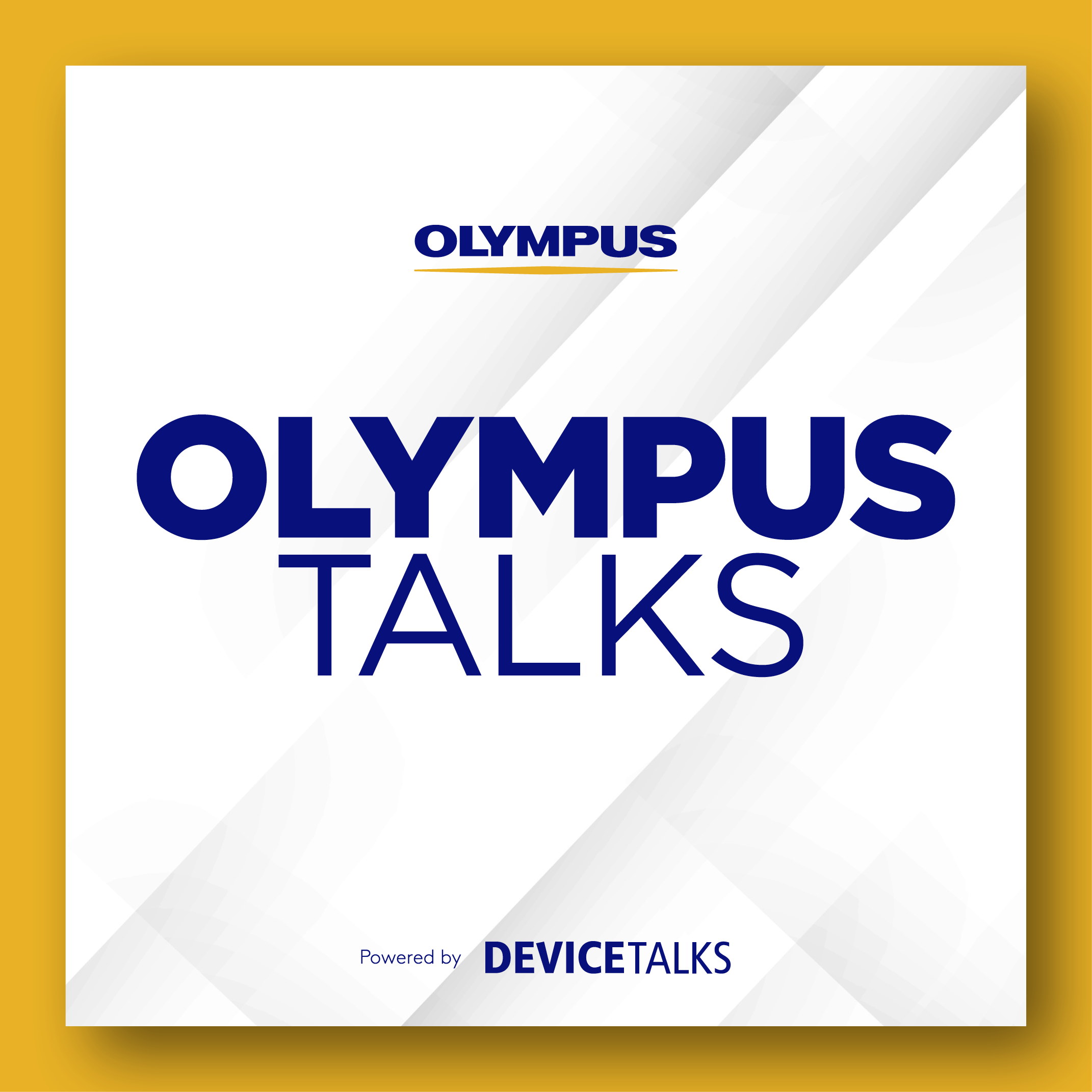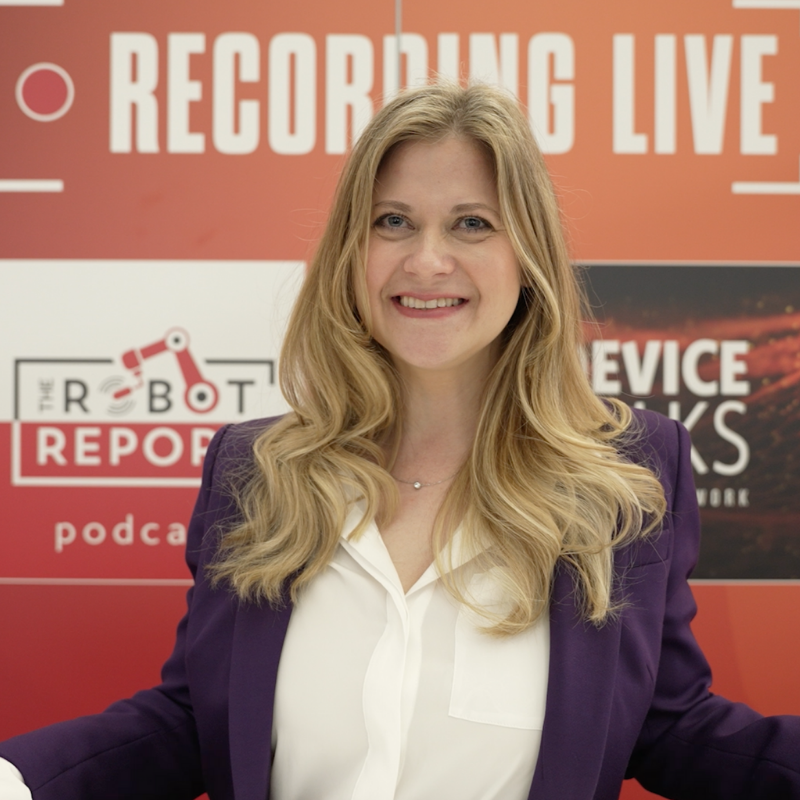Episode Transcript
Captions – Ep #5
This podcast has been paid for by Olympus Corporation of the Americas. The views and experiences shared are those of Christian Stroupe and Robert Barrett, Olympus employees. Olympus makes no representations regarding the accuracy or applicability of the content and disclaims all liability arising from its use. Product performance may vary, and techniques, instruments, and clinical decisions are unique to each facility and practitioner. Always refer to the Instructions for Use and applicable labeling for guidance, risks, and cautions. Products may not be available for sale in all regions.
Welcome to OlympusTalks, the podcast that brings you to the forefront of medical technologies as we explore advancements and innovations in GI. This eight episode series features talks with healthcare professionals, patients and Olympus subject matter experts. Listen as they dive into various aspects of GI health focused on improving patient outcomes through best practices. Stay tuned for conversations designed to educate, inspire and inform.
Well, Christian Stroupe and Robert Barrett, welcome to the podcast.
Yeah, nice to be here. Thanks Tom.
Yeah, thanks for having us.
Well, I’m eager to explore Olympus’ focus on hemostasis and the work you’re doing to control internal bleeding and GI bleeding. I want to unpack your offerings there and also talk a little bit about an article you wrote contributed recently to focusing on the ASCs. I thought it was really interesting approach, an interesting question. But before we go any further, Christian Stroupe, I’d like to understand how you found your way into the MedTech industry. I was looking at your LinkedIn profile.
Did I see a journalism degree there way back when?
That’s exactly right. Yeah. I started with a journalism degree way back when is right actually. I don’t have a blurred background. I have Florida behind me and that’s where I went. Yeah, I did the TV thing for about four years and then realized that that wasn’t for me. But I’ve been in MedTech for 17 years now and all GI. So I’ve kind of done various roles within the GI space and from sales to marketing and everything else. I guess so yeah, it’s kind of been an interesting path.
What was it that drew you to the MedTech space?
I like the clinical aspect of it. I really enjoy having the conversations with physicians and the nurses and the staff. I think it really makes, it’s really kind of interesting and kind of very challenging, you know, and obviously being able to find a way to kind of, you know, impact patients lives, I think is important as well.
That’s fantastic. And Robert, let’s, let’s unpack your background just a bit. No journalism degree. I saw, I did see you were involved with some of the sports teams where you went to school but what was, what was the lure for you that what brought you into the MedTech industry?
So I was very much interested in the technology side. So I did my degree in chemistry, I worked in a lab and I was still fairly early in my career and Olympus appealed to me. Maybe I didn’t quite understand exactly what it did, but the technology interested me. And then when I joined I really understood the impact they have to patients. And from there I moved over to the United States of America to work closer with patients and to have a more direct day to day impact from my previous role which was very long term product development side. So I’m really enjoying it over here.
And Robert, you’re a Senior Product Manager there of Core GI Procedures. Talk a bit about your role. Who do you work with internally, what areas do you cover and are you out in the field as well?
I’m part of a team that’s responsible for all the capital components of the GI endoscopy system and my small section but important section is the CV1500 video system center. So it’s kind of like the central hub. It’s where the scope connects into, it’s where the monitor connects to and it handles and processes all the image creation. There’s multiple imaging modes. So my role is to educate both the internal sales team and support the education of customers, which are physicians, on how to use the different imaging modes.
One of the imaging modes available on the system is called red dichromatic imaging and that’s a key tool in identifying the bleed point when there’s active bleeds within the GI tract.
Christian, thanks for sharing how you found your way into the MedTech industry and how you found your way to Olympus. Talk a bit about your role there. How do you work with folks internally and how do you work with folks out in the field?
So we have a team here that I kind of COVID that specifically covers the devices that go within the scope. So really the devices for hemostasis which we’re going to be talking about that offer the kind of the therapeutic piece to help stop the bleeds and that’s really kind of where we focus on. So as far as the team and myself, we kind of, we’re going out into the field, we’re supporting our sales reps, we’re supporting the, the physicians, the GI physicians that are doing these type of procedures and also the nurses and staff to make sure that they understand how the Olympus devices can really help, you know, with their bleeding needs or Hemostasis needs.
Let’s set the stage a bit. Can you give us a sense of how big, how often surgeons come up against GI bleeding? Maybe just give us a little bit of scale of or understanding of the problem.
Yeah. So in a published article from the Journal of Medical Economics, there is an annual incidence of upper gastrointestinal bleeding of around 100 to 200 cases per hundred thousand. The rate is lower for GI bleeding, but when you look at the upper GI bleeding, those cases, the mortality is between 6 to 10%. So this is a significant both burden on medical care and a risk to patients. So it’s very important that physicians have the tools needed to effectively control and prevent repeat patient care.
And Christian, is there, can you help me understand upper GI bleeding geographically? What’s upper? What’s lower within the GI system?
So, yeah, generally it’s accepted that upper GI bleeding is everything through the duodenum or the kind of the small intestine, and everything lower is the large intestine. So the colon. So upper GI would include the esophagus, the stomach, duodenum and jejunum, ileum, and then kind of the rest is all the colon. And about 70 to 75% of all bleeds are in the upper region of the body.
Let’s talk a bit about the challenges that are being brought on by gastrointestinal bleeding. It’s not something I think that we give a lot of focus to, and I think it’s something that’s probably not seen as a big a problem as it probably is. Christian, talk a bit about the challenges that healthcare providers have when it comes to dealing with gastrointestinal bleeding.
Well, I would agree. I don’t think it’s something that’s always top of mind. But GI bleeding is one of the top causes for endoscopy. I mean, it’s. If you look at it, there’s a high percentage of cases that are done just for hemostasis.
Well, Robert, let’s bring the question over to you. What’s your take on gastrointestinal bleeding? Is it getting enough attention or the attention it warranted? And what are some of the solutions that you’ve been working on at Olympus?
So I’m just going to echo Christian’s point. It’s not always top of mind, but it is very important. So at Olympus, we have a wide range of therapeutic devices, which is what Christians really the expert on. But then we have an imaging aspect to it as well, which helps identifying the bleed point. So between the visualization side and then the tool to treat the bleed. We can really help in terms of hemostasis.
So help me understand how this unfolds. What is the first sign of hemostasis or gastrointestinal bleeding during a procedure? And maybe Christian or Robert, I’ll throw it out to both of you, and you can. First one can take it, and the other one can follow up. When does the visualization sort of come into play, and when do the efforts and the treatments that go into the stopping of the bleeding? How does that unfold? What is the discovery and the treatment of gastrointestinal bleeding look like?
So, yeah, I can start. I think we can back up just a second, though. So there’s multiple different types of bleeding, right? So I think that’s maybe where we can start. And then Rob can kind of chime in for the imaging perspective like he was talking about. So for GI bleeding, there’s multiple different ways. There’s peptic ulcer disease, there’s post polypectomy bleeding, which is probably what most people kind of understand.
You go in, you have a colonoscopy, they remove a polyp, and sometimes there’s a little bit of bleeding. Sometimes it’s not enough bleeding for the physician to be concerned about. Sometimes it is, and they have to find some way to kind of do some type of therapy. There’s also more kind of advanced procedures, something like endoscopic submucosal dissection, which is kind of removing larger lesions.
And that sometimes causes that type of bleeding too. And there’s a couple other things, diverticular bleeding. But these are all kind of what leads to the hemostasis. And sometimes, you know, the patients may not know that they have the bleeding, especially if the bleeding occurs inter procedurally, because the physician’s able to kind of take care of it right away.
Well, it’s interesting about the different types of bleeds. I kind of. I’m speaking general about gastrointestinal bleeding, about hemostasis. There are certainly levels and, as I said, different types of. Robert, if you would give us your sort of overview of the different types of bleeds and what are some of the ways that they’re treated or stopped.
There’s a wide range of GI bleeding, but one of the key points is always to find the bleed, identify where the bleed is coming from, and you can achieve this through white light endoscopy. But one of the technologies we have on our EVIS X1 endoscopy system is called red dichromatic imaging. We can go into that in more detail later. But it’s a technology that really helps pinpoint where the bleed is.
Then once you can find that bleed point, then you can choose from the selection of tools and techniques available to treat the bleed. But the first step is always finding it, kind of working out what type of bleed it is, because that guides your treatment decision. And then being able to see it, know what it is, you can then make the right decision to achieve hemostasis. So it always starts with finding the bleed. And that’s what RDI technology can assist in.
We can unpack that in a moment. What are the challenges of finding a bleed? I imagine that if there’s a lot of blood, it’s difficult to find the source. Is it that simple? Or there are some more things that get in the way of easily identifying where the bleed is coming from.
So finding the actual location of the bleed can sometimes just be a challenge in itself. But once they’ve found the general area and they can see blood, they really need to understand what the cause of it is or where it’s coming from, which vessel is bleeding. And sometimes that’s obvious, as Christian said, and sometimes you don’t even need to take any action. But when it’s a larger bleed and perhaps you have a pool of blood or the blood’s coming out of the endoscope and you’re not able to see clearly, that’s when it becomes a challenge, because you just see red everywhere, and you don’t know, is it coming from the left, is it coming from the right?
So it can be a challenge. There are ways to try and pinpoint. I keep saying pinpoint, but that’s because that’s what RDI helps with. So they try and pinpoint where the bleed comes from. And they can do this by, like, flushing with the flushing pump to remove the blood and then see where the blood’s coming from. They can also suction the blood away, and they can use this in combination to achieve visibility for where the bleed point is. But that still can be really challenging because they can remove the blood and they can see where it’s coming from. Then they have to get the device in. They have to get it in place the whole time it’s bleeding, and they are losing that visibility again. So that’s the big challenge.
I was going to follow, as you were talking and I came to realize, and Christian, maybe you can offer insights here, but there’s an urgency. Obviously, when something like this happens, it needs to be fixed, and it needs to be fixed promptly when this occurs. And it occurs again, as we said, at the top, more frequently than maybe we may realize. What is the pace like for the surgeons or the physicians trying to find the bleed and find that solution?
So, yeah, I think Rob kind of said it pretty well earlier, but I think it really depends on the type of bleed. So if it’s a suspected bleed, sometimes they’re trying to find it and that’s a little more challenging. But in kind of what Rob was describing, and these kind of more massive bleeds where it is difficult to see, there’s a lot of urgency, obviously. So they’re trying to figure out whatever ways to first of identify where that bleeding point is and then figuring out what is the best therapy. So, yeah, it’s probably one of the more hectic kind of situations that we have in GI.
I think a lot of people think GI is pretty a simple procedure overall. Just you get a colonoscopy, you may remove a polyp, and that’s about the extent of it. But there are some times where it becomes a little bit more urgent. And, you know, these large bleeds are definitely fall into that category.
They’re stressful. You can be in there and suddenly it’s gone from conversational. There’s music playing to. Everyone is laser focused. And yeah, the whole atmosphere changes when there’s a significant GI bleed.
I believe that. Robert, I just want to focus a little more on RDI. What are some of the other applications for the lights? I mean, is it just the light source? Is it just used for post bleed, or can it be used in other parts of the procedure as well?
RDI has actually three modes. There’s mode one, which is focused on finding the bleed point. There’s a Mode 2, which is optimized for the observation of deep blood vessels. So when I say deep, I mean like a few millimeters in the submucosal space, not like an EUS deep. So we’re just seeing the underlying vessels. This is very useful as a planning tool. Before you do an EMR or something like an ESD where you’re cutting into that submucosal space.
So you’ve found your lesion, you decided how you’re going to remove it. And perhaps you want to inject to raise the lesion. It’s a good idea to turn on RDI mode 2, observe those and see if there’s any underlying deep blood vessels. And then it can help you plan, like where to inject or where to make your incision. Perhaps you see a blood vessel and it’s right where you have to cut and it’s completely unavoidable.
But the good thing is you’re aware of that. You can prepare the devices you want. Perhaps, maybe Christian knows better, maybe you can do something ahead to try and mitigate the risk of bleeding before you make that cut. But it’s a really good planning tool. So when you’re doing those more complex procedures, you can use the Mode 2 to help observe deep blood vessels.
I think Rob’s exactly right. I think there are times in the more complex procedures where RDI really steps up. And if we’re looking at something like a poem procedure or an ESD procedure where they’re tunneling and maybe it’s not Mode 2, but maybe it’s Mode 1. But they’re able to identify those blood vessels very clearly. And then they would use something like a Coagrasper where they would, instead of kind of just cutting through it like they normally would, they would take something that gives them a little bit more caution and they’re able to slowly seal that vessel so they don’t have a larger bleed during that complex procedure. So it really does. Even though they know that they’re going to be running across those vessels, RDI really gives the ability to kind of give them a heads up to maybe a greater degree than they normally would.
Well, let’s focus on the imaging you mentioned. The Red… is it Red Dichromatic Imaging?
Yeah, spot on. That’s it.
I rehearse before we push record. I’ll be completely honest. Talk about. Now I’m going to say RDI for the rest of that because I don’t want to push my luck. Talk about RDI and what makes it a particularly successful way of finding a bleed.
So if we go back to that scenario where there’s a large active bleeding, it’s like pooling and obscuring your visibility. So the way red dichromatic works is it makes use of a amber LED that’s unique to the CV1500 video processor. So we actually shine three wavelengths of light green, amber and red and pass it through a filter because we want very specific narrow bands of light for this to work effectively.
The amber light goes in and it hits the bleeding point. Now, amber light is highly absorbed by blood.
Oh, interesting.
So the highest point, the highest concentration is at the bleed point. Everything else surrounded is more dilute. So the bleeding point appears darker than the surrounding areas and therefore more visible. So you have the bleed, the light comes in and it’s all absorbed and it appears really dark. And that’s how you know that’s where the bleed is.
So wherever it’s darkest is where is sort of where the source of the bleed?
That is correct. So if it’s a large bleed, you can even almost sometimes see it snaking out from the blood vessel. And that gives you a really strong indication as to where you should apply your hemostasis method.
That’s a really good description, Rob, of how RDI helps find the source of the bleeding. How is it deployed? Is it part of the tools that are already in use? Is it something that needs to be brought in afterwards? Where does it fit into Olympus offerings?
So Red Dichromatic Imaging is a function of the video and light source processor. So if you have the latest generation GI processor, the EVIS X1 system, or the CV-1500 video processor, it’s included in that. And then typically the endoscopist will have it assigned to one of the scope buttons, which is a quick way for them to change between imaging modes, capture images. So the process would be they’d find.
They’d locate the area of the bleed and then they would go up close to the mucosal surface and they’d simply hit a button on the scope, just press the button, and it would bring on this RDI mode to allow them to determine where the bleed point is.
So they’re already ready to go. As soon as they detect the first sign of trouble, the RDI is there, ready to be used. That’s great. Christian, talk a bit about some of the other products that Olympus is offering in this space in terms of not only once you’ve found the bleed, what are some of the tools that are used to stop the bleeding?
Sure, yeah. No, definitely. So I think once we found the bleed through like something like RDI, it depends on the type of bleed, obviously, but many times physicians are looking to do something with mechanical hemostasis. So in that sense, we’re using clips, hemostatic clips, and, you know, Olympus offers a couple different clips, but really what they’re looking to do is they actually will capture that bleeding point with a mechanical force and that closes the bleed. And that allows them to kind of have the satisfaction that they’ve stopped the bleed and now they’ve achieved hemostasis.
That’s gonna be in probably the vast majority of hemostasis cases. We obviously have a couple other devices, and one is like a hemostatic powder. So maybe they’ve identified where that bleeding point is, again to Rob’s point. But it’s a little more challenging to get to with a clip. Cause sometimes scope position makes things challenging. So sometimes people are starting to use hemost powders. And for that, we have EndoClot PHS, which has been really helpful as far as doing it in that type of sense.
How is the powder deployed? It sounds like that would be difficult to do inside the human body.
Yeah. So most things in GI are they all come through with little catheters. So in this sense, we have a compressor that is on the backside outside of the scope. And then the physician will pass Apollo tube catheter through the scope channel. Once they’ve identified where they want to put it on, they literally are turn the compressor on and start applying powder. And they can almost what’s called painting. So they’ll spray across, you know, the mucosal area and hit not only the bleeding point, but sometimes all around it, just to make sure that they’re maybe there’s not smaller vessels that are there too, that they’re catching there too. So the benefits of a powder is really kind of more area and not have to be as precise, even though kind of with ours, we have a little bit more precision, but it gives you that ability to kind of paint the mucosal surface.
So that’s part of the EndoClot PHS system.
That’s correct. Yes, that’s right.
And the clips are the retentia hemoclip.
That’s true, yes.
All right, got that too. So, Christian, we talked about the EndoClot. We talked about Retentia. I think we also want to cover the Coagrasper. Am I saying that correctly? How does that work? What is it? And how does that help stop the bleed?
So you’re right. It is Coagrasper. So it’s basically a hot forcep. So what it allows you to do is grasp the vessel. And it’s used primarily for more interventional cases like ESD, which we talked about earlier. Endoscopic submucosal dissection, or even EMR, endoscopic mucosal resection. But what it does, they’re able to actually grab the vessel and they kind of pull back a little bit so they don’t create thermal damage to the rest of the mucosa or wherever part of the body they’re looking at.
And then they use it with a generator, and they’re applying electric current to kind of seal that vessel. Lack of a better way of describing it. So that’s kind of what they’re looking to do. It’s not used as often as you know, the hemostatic powders or hemostasis clips. Hemostasis clips are the primary hemostasis tool that GI physicians use at this point.
And let’s talk about the settings where these are used. I know you both contributed to an article that was in Becker’s talking about the use of these devices in ASCs. Are you still primarily, is your primary area of focus still the larger clinical hospitals, or do you see, and I know we’ve talked about the ASC strategy before on the podcast. Do you see a greater focus on ASCs and are they using more of these devices?
Christian, I guess that would be for you. Is that a good question?
Yeah, No, I think that’s fair. I think ASCs are. I mean, ASCs and endoscopic procedures are growing. However, generally, most of the procedures that are done in ASCs are primarily healthier patients, so we don’t see as much hemostasis needs. So if we’re talking about something like peptic ulcer disease, which we talked about earlier, that’s probably not something that the GI physician is going to see in the ASC.
So you won’t see that. What you’ll primarily see is post polypectomy bleeds. And that’s where again, everything that we’ve talked about before, from RDI to CLPS to even the hemostatic powder, that’s where we kind of play there. But it is just based on the procedures alone. It’s less than the community hospital or the academic hospital just based on the fact that they’re not doing as complex of procedures at the ASC on purpose.
All right, well, this has been a fascinating look into a space that, as we said, is often overlooked. So we appreciate the insights and thank you both for joining us on the podcast.
Yeah, thank you for having us.
Thank you, Tom.
All right, well, that is a wrap. Thanks so much for joining us on this episode of the OlympusTalks podcast. Thanks, of course, to our corporate partner, Olympus for working with us and making this great podcast series. If you’d like to find the other episodes of OlympusTalks, please visit olympusamerica.com/podcasts. Of course, we’d also love you to follow our DeviceTalks Podcast Network, you know, so you don’t miss a future episode of OlympusTalks. Also, connect with DeviceTalks on LinkedIn. Connect with myself, Tom Salemi, I’m editorial director, and our managing editor, Kayleen Brown. So we’d love to be part of your future MedTech conversations and help you find additional episodes of OlympusTalks.
Well, that’s it, folks. Thanks again for joining us on this episode of the OlympusTalks podcast.
Disclaimers: RDI™ technology is not intended to replace histopathological sampling as a means of diagnosis. RDI is a trademark of Olympus Corporation, Olympus America, Inc., and/or their affiliates. Potential complications which may be associated with the using the Olympus Coagrasper hemostatic forceps may include but are not limited to patient injury such as bleeding, thermal, infection, perforation and or mucous membrane damage that could result in death or serious injury. It may also damage the endoscope and/or instrument. For complete indications, contraindications, warnings, and cautions, please reference full instructions for use (IFU) that accompanied your product. Performing hemostasis within the GI tract is a technically demanding procedure, and the use of EndoClot™ PHS and associated devices may result in patient injury, including but not limited to inflammatory reaction, bowel rupture, and air embolism. EndoClot™ PHS is manufactured by EndoClot Plus Co., Ltd and distributed by Olympus Corp. Performing hemostasis within the GI tract is a technically demanding procedure and use of hemostatic clips and associated devices may result in patient injury including but not limited to inflammatory reaction, infection, bleeding and perforation. This device is manufactured by Yangzhou Fartley Medical Instrument Technology Co., Ltd. and distributed by Olympus. The EVIS X1™ endoscopy system is not designed for cardiac applications. Other combinations of equipment may cause ventricular fibrillation or seriously affect the cardiac function of the patient. Improper use of endoscopes may result in patient injury, infection, bleeding, and/or perforation. Complete indications, contraindications, warnings, and cautions are available in the Instructions for Use.







